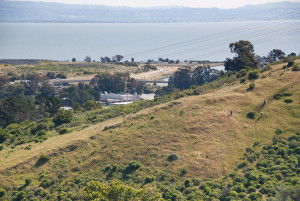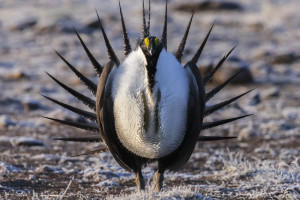On a 55-acre lot in Antioch, sandwiched in an industrial zone between a Georgia Pacific gypsum plant and some land owned by Pacific Gas and Electric, a few biologists and a crew of volunteers are waging a battle to protect a vanishing bit of the natural world. The cause isn’t easily seen: No whales are threatened and the public isn’t in danger of losing a grove of old-growth redwoods. Instead, an endangered and rapidly dwindling species of butterfly teeters on the brink of extinction.
The Antioch Dunes National Wildlife Refuge (ADNWR) was created by the United States Fish and Wildlife Service in 1980 to protect the Lange’s metalmark butterfly (Apodemia mormo langei). As described in a 2005 Bay Nature feature, the isolated dunes were fenced off from the public to protect the butterflies’ fragile habitat.
Annually since 1986, the Fish and Wildlife Service has organized a count of the Lange’s metalmark during its peak flight season in August and September.
Every Wednesday and Thursday, volunteers are escorted into the refuge to help count the butterflies and remove invasive plants. This coming Wednesday and Thursday (September 28 and 29) are the last days of this year’s count, and volunteers are still welcome to join in.
These butterflies need all the help they can get. After peaking at an estimated 2,342 individuals in 1999, the population has been on a rapid decline ever since, hitting a disturbing low of only 28 in 2010.
“We’re up slightly from last year,” says Louis Terrazas of the Fish and Wildlife Service. “But so far we only have a count of 74. We hope that number goes up within the next couple of weeks. The cooler summer may help in a late hatch; we’ll see.”
The Lange’s metalmark uses lays its eggs on only one species of host plant, the naked stem buckwheat, which is native and distinct to these dunes.
“We’re seeing plenty of buckwheat right now,” says Lois Terrazas of the Fish and Wildlife Service (FWS). “Our main problem right now, despite the low butterfly count, is invasive plants like winter vetch blanketing over all the buckwheat.”
The naked stem buckwheat is a low lying shrub and is easily overpowered by fast growing weeds like winter vetch, yellow star thistle, Russian thistle, and other invasive grasses. The micro-climate underneath the buckwheat is drowned out and prevents the survival of butterfly larvae which hatch near the base of the buckwheat plants.
That’s why pulling invasives is so important. “We really rely on community help. Cub Scouts come out a lot, high school kids; it’s a great opportunity for people to connect with this species and the unique land that it inhabits,” says Terrazas, who has been at the site since 2006.
The FWS has also employed the help of biologists from the Urban Wild Lands Group. To increase the chances of the butterfly, the biologists have taken butterflies from the site and are propagating them in other locations. In 2008 they released 60 back to the Antioch dune refuge. To see how successful different methods of release could be, they released 30 adults, 25 larvae, and five cocoons back into the wild.
Terrazas has high hopes for the future and is eager to continue expanding efforts to spread the habitat and increase the chances of the Lange’s metalmark butterfly. One potential move in the future would be working with residential neighbors to plant buckwheat nearby, expanding the butterfly’s breeding area.
For more information on how to volunteer, contact Louis Terrazas at louis_terrazas@fws.gov, (707)769-4200 (office), or (510)377-1233 (mobile).

.jpg)



